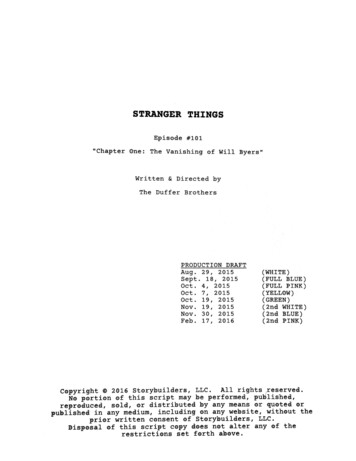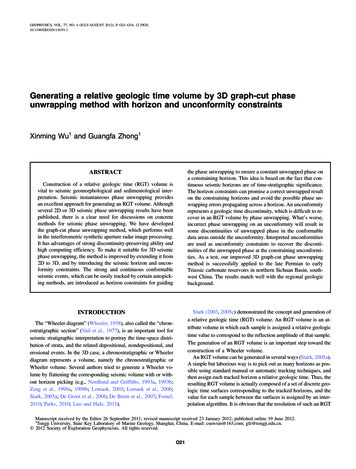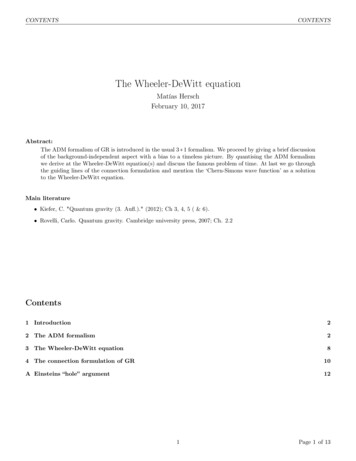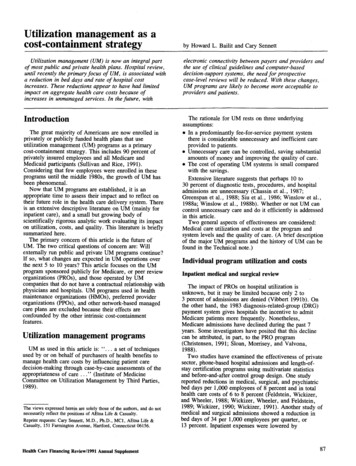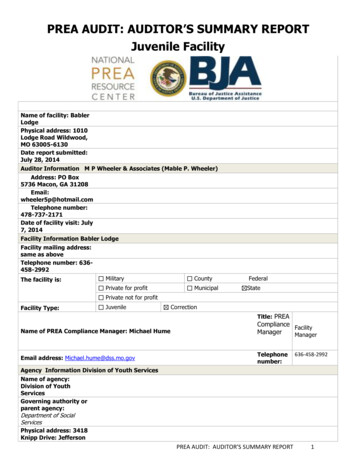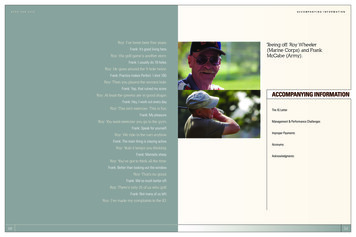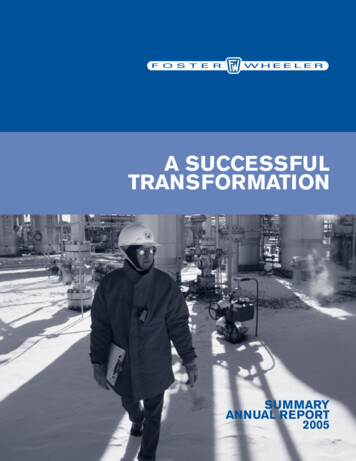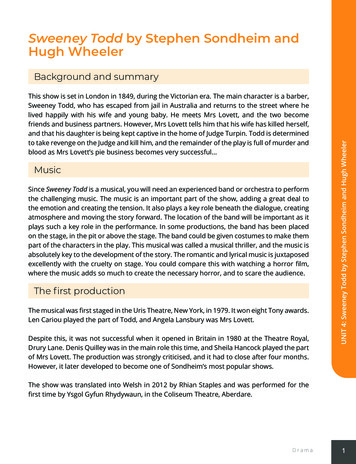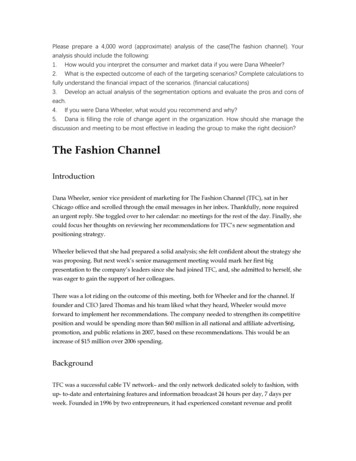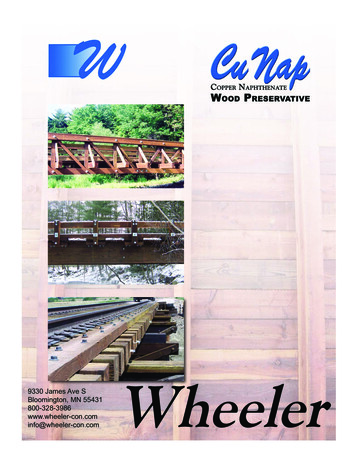
Transcription
9330 James Ave SBloomington, MN on.comWheeler
INTRODUCTIONWheeler is directed by the long-term future ofpressure treated timber for engineered woodstructures. The primary concern in selecting awood preservative is its efficacy in protecting woodfrom insects and decay. This is balanced withimpacts on the facility user and the environment.Copper Napthenate is an approved, effective, oilborne wood preservative that is consistent with thereputation established by Wheeler over a centuryof providing quality timber products.HISTORYDeveloped in Scandinavian Countries at the turnof the last century, Copper Naphthenate has beenused for over-the-counter consumer use as a brushon treatment of wood. Non-pressure applicationsinclude canvas, rope, nets, burlap, field boxes,beehives, flats, greenhouses and veterinary (hoof)treatment.It was standardized by the American WoodProtection Association (AWPA) in 1949 for brushon, dip and remedial applications. In 1989 AWPAadded standards for pressure treatment of utilitypoles, cross arms, bridge timbers, piling, industriallumber products, agricultural and highway postsand glued-laminated beams. Railroad crosstieswere added by AWPA in 2004.WHAT ISCopper Naphthenate is prepared by reacting copperwith naphthenic acid, a by-product of petroleumrefining, or sodium naphthenate. It is deliveredto the treating facility as concentrate containing8% copper in an oil carrier. The concentrate isdiluted with No. 2 oil to form the working solutioncontaining approximately 1% copper depending onthe product specifications.
BENEFITSOil-borne preservative provides added durability and waterproofing - It is resistantto weathering from wet/dry cycles compared to water-borne preservatives.Semi-transparent color reveals natural wood grain - Shades of light to darkbrown are typical. Wood may start with green tinge and then fade to browndepending on treating cycle and specie of wood.Cleaner handling - Steam cleaning after treatment greatly reduces surface oil residue.Safer to work with - It is not a dermal toxin and no photo-toxicity associated with some oil-bornepreservatives.Broad use -Commonly treated wood species can be treated to level of retention required byspecific application.Standard Duration of Load Factors used in design - There is no significant difference inresiliency compared to wood treated with other oil-borne preservatives.No corrosion concerns - Multiple studies demonstrate no excessive corrosion of hardwaredue to contact with preservative.Efficacy - USDA Forest Service Forest Products Laboratory studies document long-termperformance. American Wood Preservers’ Association (AWPA) Standards ensurepeer review and qualify intended applications.Formosan Subterranean Termite protection - University of Hawaii study demonstrateseffective protection. Situation should be considered a severe deterioration hazardand the high retention for Use Category 4C should be specified.General use pesticide - Copper Naphthenate is the only oil-borne wood preservative classifiedas general use by the United States Environmental Protection Agency (EPA) underthe Federal Insecticide, Fungicide and Rodenticide Act (FIFRA) because the EPAconcluded it has relatively low toxicity.Waste disposal - Copper Naphthenate treated wood waste is neither a listed nor a characteristichazardous waste according to the current EPA regulations under the ResourcesConservation and Recovery Act (RCRA). It may be disposed of in landfills orburned in industrial or commercial incinerators or boilers in accordance with federal,state and local regulations.100% domestic - The primary constituents of treating solution are derived and/or manufacturedfrom domestic sources by US owned companies. All timber is sourced fromdomestic mills.Documentation and studies can be found at www.wheeler-con.com, www.merichem.com, or www.coppernap.com.
FACILITYWheeler built a state-of-the-art treating facilityin 2003. The computerized wood treating facilitycombines the latest technology and high speedequipment to produce a superior product at acompetitive price.QUALITY CONTROLProducts are analyzed per strict guidelinesset forth by AWPA. Every charge is bored, corestaken and electronically analyzed to ensureproper treating. This testing is documentedand saved in the Treating Report for futurereference.All program material is certified through theAmerican Lumber Standards Committee (ALSC)and overseen by Timber Product Inspection(TPI). TPI inspects our Quality Control every 30days to ensure our product and Quality ControlProcedures meet their stringent requirements.Only after passing these requirements can atreated product be certified and tagged with the Member of WWPI, AWPA and TWC All products treated to AWPA specifications All charges assayed to certify compliance Certified TPI treatment plant WQC, BMP, ALSC inspection availableWhen projects require, products are producedin accordance with the Best Management Practices(BMP) For Treated Wood in Aquatic Environmentsissued by the Western Wood Preservers’ Institute(WWPI).
HIGHWAYCopper Napthenate is increasingly usedin highway applications. Long recognizedas the preferred field treatment, nowinstallations include pressure treatedtimber for bridge super-and substructures,railing, retaining walls, salt storagefacilities, etc.It provides an attractive appearancewithout masking the natural wood grain.Because it is waterproof, it stands up toharsh environments including road salt. Approved under AASHTO M133 First choice for brush-on fieldapplication of preservative Listed in AWPA Standards:UC3B, UC4A, UC4B & UC4CRECREATIONAs a pressure preservative, CopperNaphthenate is preferred for main structuralmembers of treated timber bridges andstructures. The waterproofing qualitiesare essential for large glued laminatedcomponents. It can be used for deckingand railing where intimate skin contact isminimal.COPPER NAPHTHENATESPECIFICATIONPRESERVATIVE TREATMENTA. This section covers the wood preservatives andthe preservative treatment of lumber and timberconforming to the Specifications as referencedor otherwise specified in the plans or specialprovisions. Temporary bracing shall not requirepreservative treatment.B. Preservative treatment of lumber and timber shallbe by the pressure process, and unless otherwiseprovided in the contract special provisions, bein accordance AWPA Standards and AASHTODesignation M 133.C. Lumber and timber specified in the plans or specialprovisions to be treated with Copper Naphthenateshall be in AWPA P9 Type A HydrocarbonSolvent.D. Unless otherwise directed by the Engineer thematerial shall be graded prior to treatment.Material shall be accepted after treatment on thebasis of its condition prior to treatment, on thebasis of inspection of the treatment proceduresubstantiated by plant records, on the conditionof the material after treatment and on absorption,penetration and visual inspection.E. So far as practicable all adazing, boring,chamfering, framing, gaining, mortising, surfacingand general framing, etc., shall be done prior totreatment. If cut after treatment, coat cut surfacesaccording to AWPA M4.F. All Douglas Fir and other species that are difficultto penetrate shall be incised prior to treatment.
RAILROADCopper Naphthenate is AWPA and AREMAapproved for treating crossties, switch ties,timbers, lumber and piling. Listed in AWPA Standards:UC4A, UC4B & UC4C Approved in AREMA Chapter 30, Section 3.7.4 Study of crossties in service for 15 yearson a heavily-trafficked Class 1 linedemonstrated comparable performanceto creosote. Webb and Brient study of hardwoodcrossties showed no significant differencein efficacy between copper naphthenateand creosote. Oak and Mixed Hardwood crosstiesunanimously adopted by AWPASubcommittee T-3 ( Piles and Ties) in 2004.SPECIALIZING IN FABRICATIONWheeler supplies treated West Coast Douglas Firand Southern Yellow Pine timbers and piling. Bridge Timbers, Piling Tapered Ties Crossties Drilling, Dapping, Planing Engineering Services TSO available Facility accessible by main-line rail Members of RTA, AREMA, REMSA
UTILITYWith more than one million polesin service, utility and communicationcompanies are specifying and installingCopper Naphthenate treated poles intheir systems.Building on historic usage as a diptreatment of poles and remedial groundline treatment for poles in service, CopperNaphthenate is a pressure treatmentoption for new poles.AGRICULTURECopper Naphthenate has become apopular option for: Fence Posts Speciality Fencing Railing Squares, Poles Electric Power Research Institutestudy compared Copper Naphthenatewith pentachlorophenol. Results ratedCopper Naphthenate slightly better onaverage than pentachlorophenol. Good gaff penetration Electrical conductivity (or electricalinsulating ability) is similar to otheroil-borne preservatives with minimalafterglow Recycling and disposal optionsavailable Listed in AWPA Standards:UC4A, UC4B & UC4C
9330 James Ave S Wheeler Bloomington, MN 55431. 800-328-3986 www.wheeler-con.com. info@wheeler-con.com
